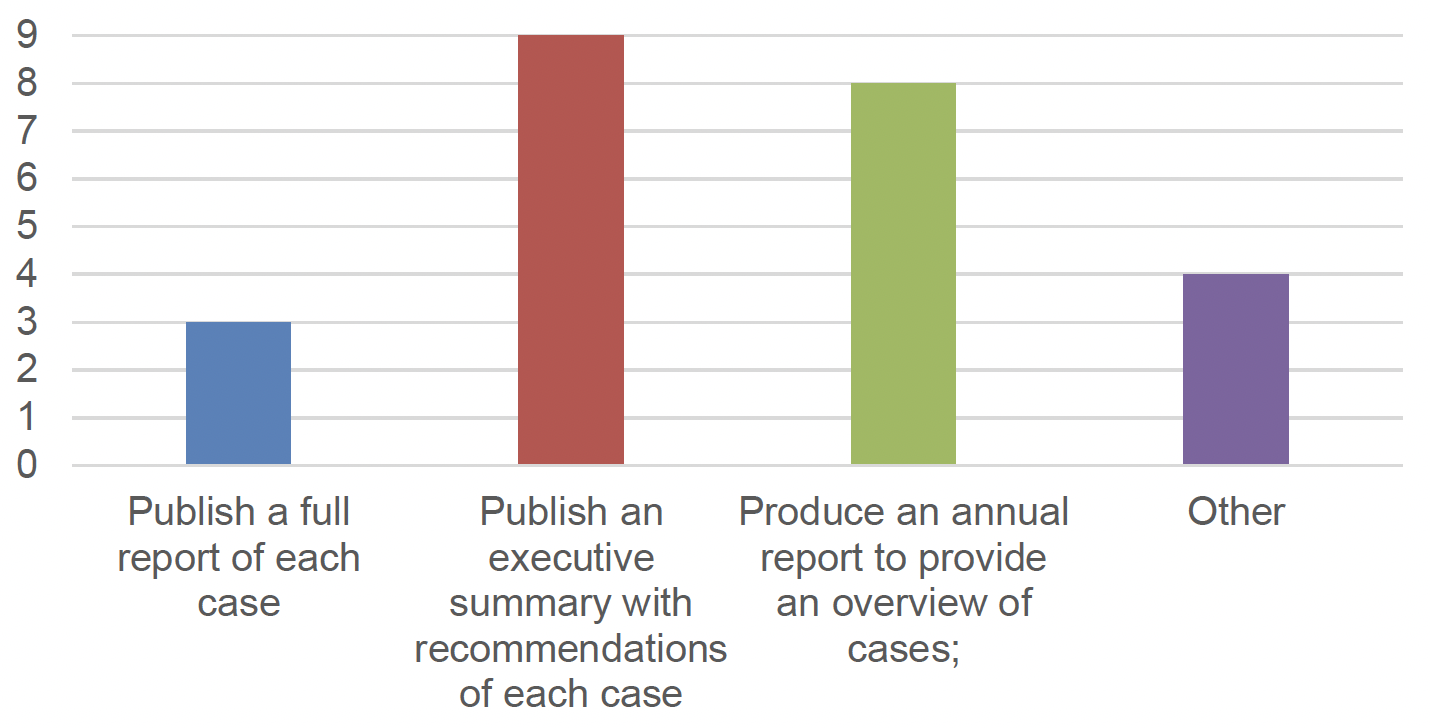Domestic Homicide Review Taskforce questionnaire: results summary
This paper provides a summary of the results of an online questionnaire issued to the Domestic Homicide Review Taskforce in December 2022.
Process of Conducting a Review
Family Involvement
The questionnaire asked respondents to provide their thoughts on how best to involve family and friends in the DHR process. Eleven people responded. There was a mix of responses on how to approach this, with common themes being the need to provide support for families, take a trauma-informed approach and provide a single point of contact/liaison officer for families. Other suggestions and comments included:
- 1 respondent suggested that the victim's family is often looking for communication, but not necessarily direct involvement
- 1 respondent pointed out the importance of including children under 18 years of age
- 1 respondent suggested that family involvement should be limited to next-of- kin only, while another respondent suggested it was important to include wider family members
- England/Wales was mentioned by 1 respondent as a good model to consider in relation to international best practice
- 1 respondent suggested that by involving family and friends this gives them the opportunity to honour the victim and tell the victim's story
- 1 respondent thought that it should be clear to friends and family what the purpose of the DHR process and their involvement is, and that there should be a consistent format for engagement
- 1 respondent mentioned that it is important to ensure engagement does not jeopardise any criminal investigation
- 1 respondent mentioned that respect and understanding should be integral to the process
Interagency Working
Ten respondents shared their thoughts on how best to ensure co-operation and participation of key agencies. The most common suggestion was the need for statutory guidance and/or legal obligations (n=6). Other suggestions included:
- 1 respondent suggested that there should be a protocol/MOU between multi-agency parties
- 1 respondent suggested to embed the learning in Equally Safe
- 1 respondent mentioned the importance of ensuring all views and contributions are respected
- 1 respondent suggested that agencies must feel safe and supported and that some awareness raising on what a DHR is might need to happen before implementation
- 1 respondent mentioned providing training
- 1 respondent highlighted the importance of demonstrating effectiveness/evidencing impact
- 1 respondent thought that it should be emphasised that the DHR is a learning process and this should be built into all of the narrative and guidance which underpins the process.
Reporting and Monitoring
Respondents were asked how cases should be reported on. Responses are shown in Figure 3 below.

Several respondents suggested a combination of the options that were given, in particular a combination of publishing an executive summary and an annual report.
Three respondents suggested that publishing a full report of each case might not be appropriate, due to the level of detail. However, one respondent suggested that in some cases it might be appropriate, for example for local agencies to have access to the full report.
One respondent suggested that it is important to publish key learning and recommendations, but that it would be essential to bring this together in a comprehensive way.
When asked to whom outcomes should be reported, a variety of suggestions were made:
- Heads of relevant agencies (n=4)
- Scottish Government/ Scottish Ministers (n=4)
- Public Protection Chief Officers Group (n=2)
- Relevant stakeholders (n=2)
- The Lord President (n=1)
- The victim's family (n=1)
- Violence Against Women and Girls Partnerships (n=1)
- Taskforce members (n=1)
- Whoever has the power to enforce recommendations (n=1)
One respondent suggested it is important that there is accountability for individual cases, at both an organisation and wider system level.
The questionnaire asked where DHR reports should be held. Three of the eight respondents who answered the question suggested a central/independent repository. Other responses included:
- A national DHR committee and PP COGs (Public Protection Chief Officers Group)
- Confidentially within Health and Social Care Partnerships (HSCP)
- Public Health Scotland
- Scottish Government
One respondent thought it was important for reports to be publicly accessible.
Eleven Taskforce members made suggestions on how to ensure DHR recommendations are followed up:
- 3 respondents said that follow-up could be ensured through a progress report, with one respondent suggesting this should be publicly available.
- 3 respondents suggested a national monitoring scheme. One respondent suggested a progress report should be part of such a scheme. One respondent referred to the existing Public Protection processes as an example of good practice.
- 2 respondents drew attention to the importance of training and development for staff.
- 3 respondents mentioned the need for a systematic approach that would produce action plans. One of the respondents added that the action plans needed to be monitored and audited.
- 1 respondent proposed that follow-up should be incorporated as part of a protocol/MOU that reflects commitments from relevant agencies.
- 1 respondent mentioned the need for preparatory funding.
- 1 respondent suggested that follow-up can be ensured through the clinical and care governance processes of a HSCP.
- 1 respondent thought that an independent domestic abuse commissioner should be established in the future, with the power to enforce recommendations.
- 1 respondent suggested that follow-up should be ensured through the efforts of the organisation or official to whom the outcomes are directed to.
Contact
Email: DHRmodel@gov.scot
There is a problem
Thanks for your feedback